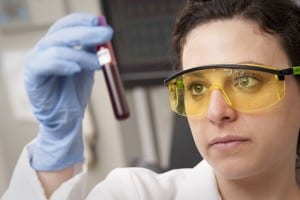Lunch Hour Lecture: Ovarian cancer screening — the long journey
By Ella Richards, on 15 March 2016
Will effective screening for ovarian cancer, one of the most common cancers affecting women, ever become a reality?
A group of researchers started to reach for this goal more than 30 years ago. As Professor Usha Menon (UCL Institute for Women’s Health) explained in her Lunch Hour Lecture, determining a method of diagnosing early stage ovarian cancer is almost in touching distance.
What is ovarian cancer?
Ovarian cancer is cancer of the ovaries and fallopian tubes, and it is the fifth most common cause of cancer-related deaths in women in Europe.
Unfortunately most ovarian cancer patients do not have clear symptoms in the early stages of the disease, meaning that 55% of women with ovarian cancer are diagnosed in stage III or IV, when the cancer is harder to treat.
Moreover, there is a 90% survival rate when ovarian cancer is diagnosed at stage I, however only a 5% to 20% survival rate for five years when diagnosed at stage III or IV.
What was the aim of the trial?
With these stark statistics, the trial’s “whole rationale is to use screening to try to pick up this disease earlier, when treatments can make a difference.”
As Professor Menon outlined, “the journey starts a long time ago in 1981.”
Throughout the 1980s and ‘90s there were large research breakthroughs in identifying ovarian cancer.
Scientists discovered that levels of the protein CA125 in the blood increase in women with ovarian cancer, even before a woman develops obvious symptoms.
This method was then honed to create a Risk of Ovarian Cancer Algorithm (ROCA), which aimed to calculate a woman’s estimated risk of having ovarian cancer based on her levels of CA125, and specifically the rate at which her levels of CA125 increased.
Similarly, researchers in London discovered that ultrasound could be used to examine ovaries for potentially cancerous cysts.
None of the research trials, however, were large enough to provide conclusive data.
The Trial
As a result, in 2001, a team from around the world came together to conduct the UK Collaborative Trial of Ovarian Cancer Screening (UKCTOCS), one of the largest randomised controlled trials ever.
They recruited more than 200,000 postmenopausal women via 13 centres across the UK to test how effective two forms of screening were in detecting ovarian cancer.
The researchers assigned the women up in a 1:1:2 ratio to screening by measuring levels of CA125 in the blood followed by ultrasound for women whom ROCA deemed at risk; screening using just ultrasound; and leaving the largest group as a control.
Issues with the Trial
As the team soon found out, conducting such a large trial raises problems well before you get any results.
As Professor Menon explained, one person was needed throughout the trial just to answer calls from women taking part.
1.2m invitations were sent out to women from across the UK and, due to tight funding, the researchers had to get their relatives in place of actors to film the information video sent out to all potential volunteers.
Once the trial began, 500 to 600 samples were arriving at the research headquarters every day and the team did not have the space to store them. The sample freezers, each holding 35,000 samples, spilled out into a garden shed at Queen Mary University before UCL stepped in to pay for commercial storage in 2004.
By 2007, the end of the initially proposed six year trial period, it was clear to the team that the control group, and thus the women partaking in the trial as a whole, were abnormally healthy: their ovarian cancer-caused death rates were significantly lower than the UK population.
Not giving up, the team looked for further funding and extended the trial, firstly by five years and then by a subsequent three years to 2014.
The initial results
Firstly, the team’s initial hypothesis that ROCA would be more effective in picking up ovarian cancers than a standard CA125 cut-off appeared to be proven true, as the data showed that some women’s higher levels of CA125 were caused by other factors.
Most enticingly, death rates among the women given the annual blood test and the women given an annual ultrasound were around 20% lower than women in the control group. This means that for every 10,000 women screened for between 7 and 11 years, around 15 lives could be saved.
There were, however, complications. Firstly there was a significant number of false positive results from the blood test and even more from the ultrasound method; this meant that for every woman who had ovarian cancer, four women had unnecessary surgery.
Concerns were thus raised over the harm of the screening, firstly the dangers of unnecessary surgery, and, secondly, the mental anxiety caused by false alarms and false all-clears.
More important, the statistical confidence interval means that the mortality reduction could lie anywhere between 0% and 40%, and the team need to continue the long-term study in order to reduce this confidence interval and gain more reliable data.
Where now?
After extending the trial twice already, Professor Menon and her team have extended it again until the end of 2018, hoping that the next three years of research will confirm that screening reduces mortality rates significantly.
As Professor Menon said, “this research has been 30 years in the pipeline”, and it will surely be worth three years more to save more women’s lives.
 Close
Close



